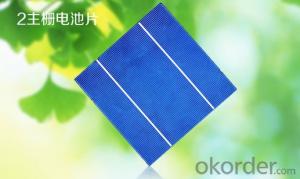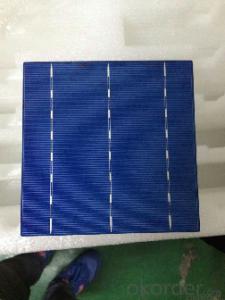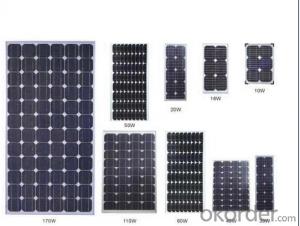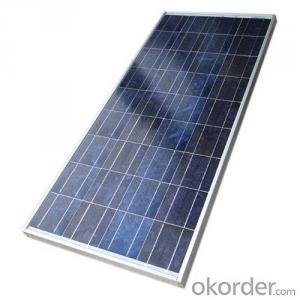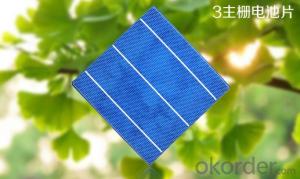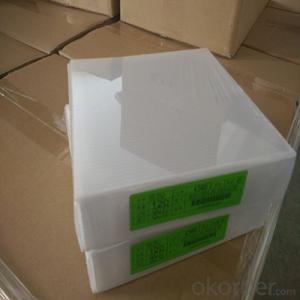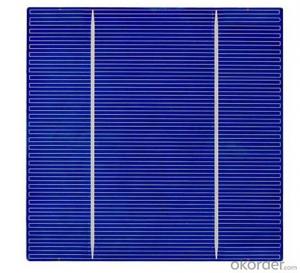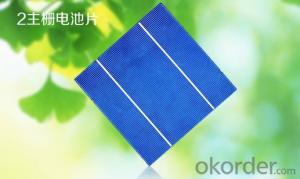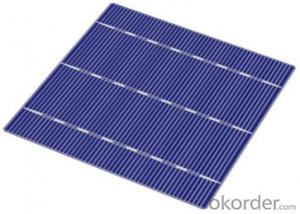Ja Solar Cells 2bb Line
- Loading Port:
- China Main Port
- Payment Terms:
- TT OR LC
- Min Order Qty:
- -
- Supply Capability:
- -
OKorder Service Pledge
OKorder Financial Service
You Might Also Like
Solar Cell Characteristics
• High efficiency and stable performance in photovoltaic conversion.
• Advanced diffusion technique ensuring the homogeneity of energy conversion efficiency of the cell.
• Advanced PECVD film forming, providing a dark blue silicon nitride anti-reflection film of homogenous color and attractive
appearance.
• High quality metal paste for back surface and electrode, ensuring good conductivity, high pulling strength and ease of soldering.
• High precision patterning using screen printing, ensuring accurate busbar location for ease with automatic soldering a laser cutting.
THE CHARACTERISTIC OF 156P POLY-SILICON SOLAR CELLS
1.Format 156mm×156mm±0.5mm,Thickness 210μm±30μm.
2.High efficiency in photovoltaic conversion 16.3%~17.93%;
3.Low inverse current, high shunt resistance and high dependability.
4.Front(-): covered by dark blue silicon nitride anti-reflecting coating(silicon nitride) with bus bars(silver), 2/3/5 bud bars(silver).
5.Back(+): wide soldering pads(silver), back surface field(aluminum),high quality paste for the BSF and the electrode ensure higher tension and improve soldering easiness.
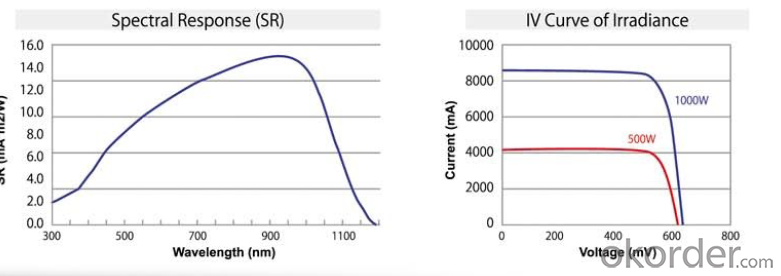
- Q: What are the tin bands, sinks and interconnections used on solar modules, and what are the solar cells used in the solar cells?
- At present, the general crystal silicon cells using p-type silicon, in the phosphorus diffusion process, the two sides of the silicon and the edge will be phosphorus doping.
- Q: How do solar cells perform in high altitude environments?
- Solar cells perform better in high altitude environments due to several factors. Firstly, at higher altitudes, there is less atmospheric interference, resulting in reduced scattering and absorption of sunlight. This allows solar cells to receive more direct and intense sunlight, increasing their efficiency. Secondly, the lower temperatures at higher altitudes help solar cells operate more efficiently as they generate less heat, reducing the risk of overheating. Finally, the thinner air at higher altitudes allows for better heat dissipation, further enhancing the performance and lifespan of solar cells. Therefore, solar cells are generally more effective and efficient in high altitude environments.
- Q: Can solar cells be used for space applications?
- Yes, solar cells can be used for space applications. They are commonly used to power satellites and spacecraft by converting sunlight into electricity.
- Q: Can solar cells be used in shopping centers?
- Yes, solar cells can be used in shopping centers. They can be installed on rooftops or in parking lots to generate clean and renewable energy, helping to reduce electricity costs and carbon emissions. Solar cells can also be integrated into the design of buildings, such as glass facades or awnings, allowing shopping centers to harness solar power while maintaining aesthetic appeal.
- Q: How do solar cells perform in areas with high levels of salt spray?
- Solar cells generally perform well in areas with high levels of salt spray. However, prolonged exposure to salt spray can potentially corrode the surface of the cells, reducing their efficiency over time. Regular maintenance, such as cleaning and protective coating, can help mitigate the effects of salt corrosion and ensure optimal performance.
- Q: Can solar cells be used in underwater vehicles or submarines?
- Yes, solar cells can be used in underwater vehicles or submarines as a source of renewable energy. However, their efficiency can be significantly reduced due to the limited amount of sunlight that reaches underwater. Nonetheless, advancements in solar cell technology are being made to optimize their performance in such environments.
- Q: How do solar cells perform in polluted environments?
- Solar cells tend to perform less efficiently in polluted environments. Airborne pollutants, such as particulate matter and smog, can reduce the amount of sunlight reaching the solar cell's surface, thus decreasing its power output. Additionally, pollutants can accumulate on the surface of the solar cell, creating a film that further reduces the absorption of sunlight. Therefore, regular cleaning and maintenance are crucial to maintain optimal performance in polluted areas.
- Q: Can solar cells be used in powering e-bikes?
- Yes, solar cells can be used in powering e-bikes. Solar panels can be installed on the surface of an e-bike or on a separate charging station to harness solar energy and convert it into electrical power. This power can then be used to charge the e-bike's battery, extending its range and reducing the reliance on grid electricity.
- Q: Can solar cells be used to power agricultural irrigation systems?
- Yes, solar cells can be used to power agricultural irrigation systems. Solar panels can convert sunlight into electricity, which can be used to power pumps and other equipment necessary for irrigation. This renewable energy source can provide a sustainable and cost-effective solution for powering irrigation systems in remote or off-grid areas.
- Q: What is the role of surge protectors in solar cell systems?
- The role of surge protectors in solar cell systems is to protect the system from voltage spikes or surges that can damage the solar panels, inverters, or other sensitive electronic components. Surge protectors help to regulate and divert excessive voltage to prevent equipment failure and ensure the overall stability and longevity of the solar cell system.
Send your message to us
Ja Solar Cells 2bb Line
- Loading Port:
- China Main Port
- Payment Terms:
- TT OR LC
- Min Order Qty:
- -
- Supply Capability:
- -
OKorder Service Pledge
OKorder Financial Service
Similar products
Hot products
Hot Searches
Related keywords
